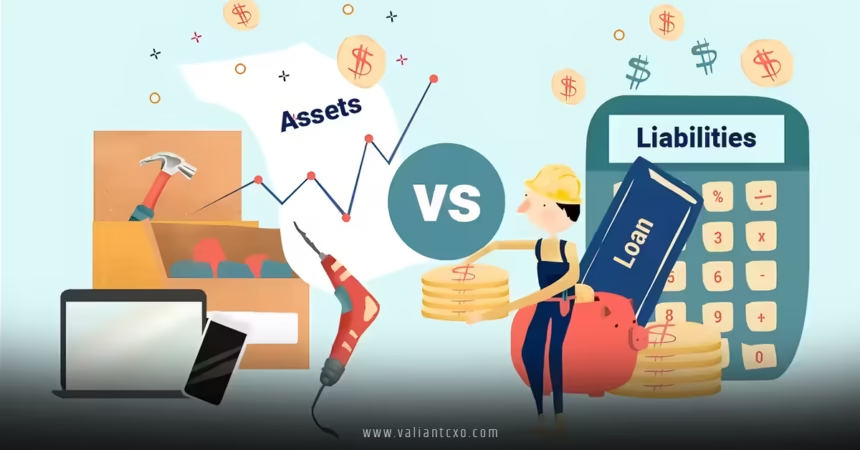Simple explanation of assets vs liabilities starts with breaking down these two fundamental concepts in personal finance that can make or break your financial health. Imagine you’re building a house—assets are the sturdy bricks that support and grow your structure, while liabilities are the cracks or loans that could weaken it if not managed well. In this article, we’ll dive deep into what they mean, why they matter, and how you can use this knowledge to your advantage. Whether you’re a newbie dipping your toes into budgeting or someone looking to refine your money game, stick around because we’re keeping it straightforward, relatable, and packed with insights.
Why You Need a Simple Explanation of Assets vs Liabilities Right Now
Let’s face it: money talks can feel overwhelming. Have you ever stared at your bank statement wondering why some numbers feel like wins and others like weights? That’s where a simple explanation of assets vs liabilities comes in handy. Assets are essentially the things you own that have value and can put money in your pocket over time. Think of them as your financial allies. Liabilities, on the other hand, are what you owe—debts that can drain your resources if they spiral out of control.
In today’s fast-paced world, understanding this duo isn’t just nice-to-know; it’s essential. With inflation biting and economic shifts happening left and right, grasping a simple explanation of assets vs liabilities empowers you to make smarter decisions. For instance, buying a car might seem like an asset, but if it’s financed with a high-interest loan, it could tip more toward liability territory. We’ll explore these nuances to help you build a solid foundation.
Breaking Down Assets: The Building Blocks in a Simple Explanation of Assets vs Liabilities
Assets form the positive side of your financial equation in any simple explanation of assets vs liabilities. Simply put, they’re items or resources that hold economic value and can be converted into cash or generate income. But let’s not stop at definitions—let’s make this real.
Picture assets as your team’s star players in a game of financial soccer. They score goals for you. There are two main types: current and non-current. Current assets are quick wins, like cash in your wallet, savings accounts, or stocks you can sell fast. Non-current assets? Those are long-game heroes, such as real estate, retirement funds, or even intellectual property like a patent.
Why do assets rock? They appreciate or provide returns. Take a house: it might increase in value over years, or you could rent it out for passive income. In a simple explanation of assets vs liabilities, assets boost your net worth—the difference between what you own and what you owe. I’ve seen friends turn modest investments into life-changing wealth by focusing here. What if you started small, like investing in a low-cost index fund? It could grow exponentially, thanks to compound interest.
But hold up—not all assets are created equal. Some depreciate, like that fancy gadget that loses value the moment you buy it. In our simple explanation of assets vs liabilities, we emphasize quality over quantity. Prioritize assets that work for you, not against.
Examples of Everyday Assets in a Simple Explanation of Assets vs Liabilities
Diving deeper, let’s list some relatable examples to flesh out this simple explanation of assets vs liabilities. Cash and equivalents top the list—they’re liquid and ready to use. Then there’s inventory for business owners, which can turn into sales revenue.
Investments shine bright here too. Stocks, bonds, mutual funds—they fluctuate but often yield dividends or capital gains. Real estate? A classic. Owning property can hedge against inflation and provide rental income. Even your car counts as an asset if it’s paid off and holds resale value, though it depreciates.
Don’t forget intangible assets like copyrights or trademarks. If you’re a creator, these can be goldmines. In a simple explanation of assets vs liabilities, recognizing these helps you audit your life. Ask yourself: What’s putting money back in my pocket?
Unpacking Liabilities: The Other Side in a Simple Explanation of Assets vs Liabilities
Now, flip the coin to liabilities in our simple explanation of assets vs liabilities. These are obligations—debts you must pay back, often with interest. They’re like anchors that can slow your financial boat if not handled wisely.
Liabilities come in short-term and long-term flavors. Short-term ones, or current liabilities, include credit card balances, utility bills, or payday loans—stuff due within a year. Long-term? Mortgages, student loans, car financing—these stretch out, sometimes for decades.
Why do they matter in a simple explanation of assets vs liabilities? Because unchecked, they erode your wealth. Interest compounds against you, turning a small debt into a monster. I’ve chatted with folks who ignored this and ended up in a cycle of payments. But liabilities aren’t all bad; smart ones, like a business loan to expand, can lead to more assets.
Think of it metaphorically: Assets are sunshine, liabilities storm clouds. Balance them, and you get a rainbow—financial freedom.
Common Types of Liabilities Explained in a Simple Explanation of Assets vs Liabilities
To keep this simple explanation of assets vs liabilities practical, let’s spotlight common liabilities. Credit card debt is a sneaky one; high interest rates can balloon it fast. Mortgages are hefty but often necessary for homeownership—aim for affordable terms.
Student loans plague many, but income-driven repayment plans can ease the burden. Auto loans? Fine if the car boosts your productivity, but avoid overextending. In business, accounts payable—money owed to suppliers—counts too.
Taxes owed are liabilities until paid. The key in any simple explanation of assets vs liabilities? Track them religiously. Use apps or spreadsheets to stay ahead.
Key Differences: Assets vs Liabilities in a Simple Explanation
Here’s where the rubber meets the road in our simple explanation of assets vs liabilities: the differences. Assets increase your wealth; liabilities decrease it. Assets generate income or appreciate; liabilities cost you money through payments and interest.
Ownership vs. obligation—that’s the crux. You control assets, but liabilities control you until settled. In balance sheets, assets sit on the left, liabilities on the right with equity.
Rhetorically, which would you rather pile up? In a simple explanation of assets vs liabilities, the goal is maximizing the former while minimizing the latter. Net worth = Assets – Liabilities. Positive? You’re winning. Negative? Time to strategize.
Analogies help: Assets are like planting seeds that grow into fruitful trees. Liabilities? Borrowing tools to plant but paying rent on them forever if not careful.
How to Calculate and Compare in a Simple Explanation of Assets vs Liabilities
Calculating is straightforward in this simple explanation of assets vs liabilities. List all assets: add up cash, investments, property values. Tally liabilities: sum debts, loans, bills.
Subtract liabilities from assets for net worth. Tools like Investopedia’s net worth calculator can help visualize. Compare ratios too—like debt-to-asset ratio. Under 0.5? Solid ground.
In practice, review quarterly. Adjust by paying down high-interest liabilities first, then building assets.
The Importance of Balancing Assets and Liabilities: Insights from a Simple Explanation
Why obsess over balance in a simple explanation of assets vs liabilities? It dictates your financial stability. Too many liabilities? Risk bankruptcy or stress. Abundant assets? Security and growth.
For businesses, it’s survival—lenders check this before loans. Personally, it affects credit scores, loan approvals, even peace of mind. I’ve advised friends to shift focus: Sell unused assets to clear debts.
Economic downturns highlight this. During recessions, assets might dip, but low liabilities cushion the blow. In our simple explanation of assets vs liabilities, balance equals resilience.
Strategies to Optimize in a Simple Explanation of Assets vs Liabilities
Optimizing starts with budgeting in this simple explanation of assets vs liabilities. Track income/expenses to free cash for asset building. Debt snowball method: Pay smallest liabilities first for momentum.
Invest wisely—diversify into stocks, real estate via Khan Academy’s finance courses. Emergency funds as assets buffer against surprise liabilities.
Refinance high-interest debts. Side hustles generate income to buy assets. Consistency wins.
Real-Life Scenarios: Applying a Simple Explanation of Assets vs Liabilities
Let’s get personal with scenarios in our simple explanation of assets vs liabilities. New grad with student loans (liability) but starting salary (potential asset via savings). Strategy: Live frugally, invest in 401(k).
Homebuyer: Mortgage (liability) for house (asset). If property appreciates faster than interest, win. Entrepreneur: Business loan (liability) funds inventory (asset). Sales turn it profitable.
Retiree: Pension (asset) vs. medical bills (liability). Planning ahead matters. These stories show a simple explanation of assets vs liabilities isn’t abstract—it’s life-changing.
Common Mistakes to Avoid in Understanding Assets vs Liabilities Simply
Even with a simple explanation of assets vs liabilities, pitfalls abound. Mistake one: Confusing wants with assets. That luxury watch? Depreciates, more liability if bought on credit.
Ignoring inflation—assets must outpace it. Overleveraging: Too much debt chasing assets crashes hard. Not diversifying assets leads to risks.
Emotional decisions: Selling assets in panic or accumulating liabilities impulsively. Learn from NerdWallet’s debt management tips. Stay educated.
Conclusion: Mastering the Simple Explanation of Assets vs Liabilities for a Brighter Future
In wrapping up this simple explanation of assets vs liabilities, remember: Assets build wealth, liabilities can hinder it, but balance is key. You’ve got the tools—definitions, examples, strategies—to take control. Start today: Audit your finances, prioritize smart choices, and watch your net worth soar. Financial freedom isn’t a dream; it’s a decision. Go forth and conquer your money story!
FAQs
What is the core difference in a simple explanation of assets vs liabilities?
The core boils down to ownership versus obligation—assets are what you own that add value, while liabilities are debts you owe that subtract from it.
How can beginners apply a simple explanation of assets vs liabilities to budgeting?
Start by listing your assets like savings and subtracting liabilities like loans to see your net worth, then budget to grow the positives.
Are there good liabilities in a simple explanation of assets vs liabilities?
Yes, like mortgages or business loans that help acquire appreciating assets, as long as they generate more value than they cost.
Why is net worth important in understanding assets vs liabilities simply?
Net worth, calculated as assets minus liabilities, gives a snapshot of your financial health and guides better decisions.
Can investments change from assets to liabilities over time?
Absolutely—if an investment loses value or incurs ongoing costs without returns, it might shift, highlighting the need for regular reviews.
Read Also:valiantcxo.com


